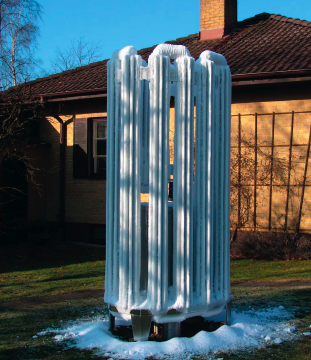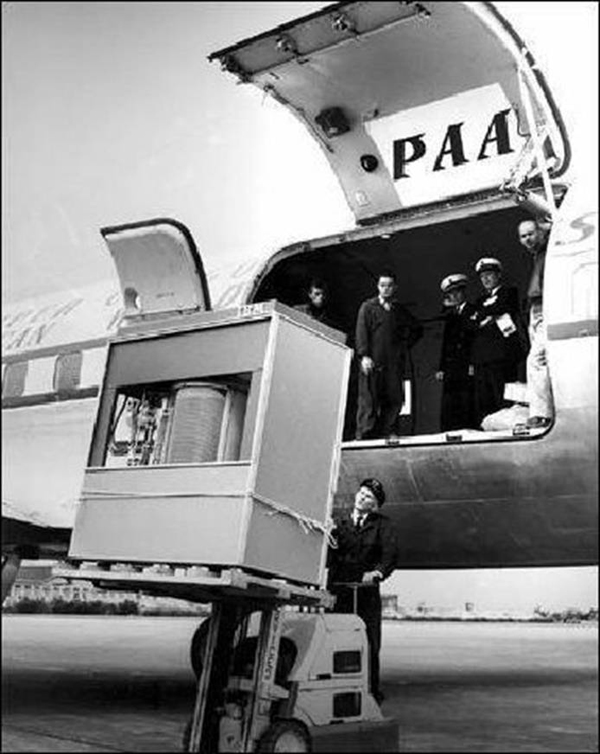What's This?
-
Any Ideas?

-
It looks like some kind of a cooling tower. There is definitely a path for the flow of a fluid. The vertical members have what look like fins to increase surface area and heat transfer. That's what it looks like, but . . .
-
It looks like it may have frost on it, meaning that it is cooler than its environment, making it a warming tower, which I've never heard of.
-
It appears to be next to a residence rather than in some kind of industrial area.
-
There's snow or accumulated frost on the ground next to it. And based on the distribution of snow, it doesn't look like the spot gets much sunlight, which doesn't make sense for a "warming tower".
Now, it could be some sort of a heat pump, but forced air ventilation and much more radiative surface would be necessary.
I don't know, but I'm curious.
-
-
Based off of the distribution of the "frost" on the ground, it looks like it was dropped there shortly before taking the picture, roughly enough to knock some of the frost off. Do you know whither this is correct?
Is whither the right word, or am I spelling a homophone of what I'm trying to say?
-
@unknownuser said:
Based off of the distribution of the "frost" on the ground, it looks like it was dropped there shortly before taking the picture, roughly enough to knock some of the frost off. Do you know whither this is correct?
Is whither the right word, or am I spelling a homophone of what I'm trying to say?
I think you are looking for whether. But even as i type it it seems incorrect. Oh well the Firefox spell check says its fine, which is funny because it says Firefox isn't a word (just added it to the dictionary).
-
It's appears to be a malfunctioning time suspension chamber that is in the process of sheading its invisibility cloak. (Looks also to have already lost its prisoner...though such appearances can be quite deceiving :`)
-
It could be part of a carbon dioxide fire suppression system. I worked at a place that had something similar, although on a much larger scale. Plus there should be storage tanks for the liquid CO2 to go along with it.
-
John was the closest ...... well done Sherlock, you were nearly there

Ice-Stick is what you are looking at. A Swedish heating system that I just came across, check it out here, http://www.octopus.tm/eng/index.htm
Mike
-
Oh, that's what I meant
 . I suppose the fluid under pressure near its condensation point is what makes it work. It's an Octopus Model IS 61 of course
. I suppose the fluid under pressure near its condensation point is what makes it work. It's an Octopus Model IS 61 of course  .
.Looks interesting and worth exploring, but I'd want to see some some independent data on its efficiency.
-
It cannot be very efficient in regions with temperature often below the freezing point. Heat pumps are quite common here in Finland, but in permenent dwellings the tubes are most often put under the ground, or in a deep well, or in the bottom of a pond or lake, and in holiday cabins they use a simple air heater that doubles as an air conditioner in the summer. It is easier to extract heat from materials heavier than air. The plus side of this device must be that it might be much less noisy than an air heater.
I noticed that the marketing of this device was focussed to the south of Sweden and the Baltic countries, so regions somewhat warmer than ours.
Anssi
-
My father is a heating/cooling guy (for years and years)
I sent him this and he wrote...@unknownuser said:
This is basically a scam! (how they are marketing it)
Not the fact that it is a Freon based water cooling system just like 25 % of the units are in the US. But in the fact of HOW they are trying to sell it.
They have changed up some of the words to make this system sound new and wonderful. They have redesigned the condenser to make it more eye-pleasing to look at (I like it's look). They are heavily stressing the "environmental" buzz words, that are politically correct of today. They call it a "Heat Pump", which it is not.
Bottom line: It's the same old Water Cooler that is used to good effect in a lot of houses (and almost all commercial buildings) today. I noticed that they call it a "Heat Pump", it is not. A Heat Pump can both cool and heat the house but is a direct expansion unit. I see in the writing that they say if you need heating you have to put in an augmented heating system. This unit is a water cooling system. It cools water and the cold water is pumped through the house. I love these types of systems. They deliver a more efficient and better distributed cooling (or heating) effect. Fewer cold or hot spots. They are generally cheaper to run, however, more expensive to install. That's why you hardly ever see them in the lower to middle class houses.
-
It looks very much like part of our medical oxygen system at work. The oxygen is liquid as it comes out of the Dewar and cools the plumbing as it vaporizes before it goes to the first stage of regulation. Of course our system is much larger than the one in the picture.
-
I thought for sure it was the biggest popsicle EVER... like for King Kong...
-
Anssi
There are new heat pump air-to-water coming from Japan which works so far than minus 25°C. Here ground surface collectors are not so good, and their productions go down quite a lot after 3 to 4 years.
In France, our numerous nuclear plants distract our governement to be helpful with new energies.
Marc -
Rather than start a new thread I figured this would be a continuation of Mike's original...
So, what's this guys?

-
I know what it is so I won't say.
But I will date it for you as being from 1956.
-
I do too %(#FFFFFF)[- it's an IBM 305 RAMAC.
That central cylinder is a hard drive. IBM introduced the hard drive (RAMAC) in 1956; it stored 5Mb [that's Mb NOT Gb !!!] in an enclosure the size of a big refrigerator, and cost ~$150,000. 1Tb now costs ~£300 !!! So we now have ~10,485,760 more space per dollar after 50+ years of development: it also fits in a much smaller volume...] my
text is very small for those who don't want to know...
-
I had guessed it was a computer of some sort. Wow, imagine having to lug it around. I imagine there is now more power in a cheap $10 calculator

-
Yep, here was the explanation in the email I got from a friend.
@unknownuser said:
It's a hard disk drive back in 1956... with 5 MB of storage. In September 1956 IBM launched the 305 RAMAC, the first 'SUPER' computer with a hard disk drive (HDD). The HDD weighed over a ton and stored a 'whopping' 5 MB of data.
Do you appreciate your 8 GB memory stick a little more now?
And if you could not read TIG's post...
@tig said:
- it's an IBM 305 RAMAC.
That central cylinder is a hard drive. IBM introduced the hard drive (RAMAC) in 1956; it stored 5Mb [that's Mb NOT Gb !!!] in an enclosure the size of a big refrigerator, and cost ~$150,000. 1Tb now costs ~£300 !!! So we now have ~10,485,760 more space per dollar after 50+ years of development: it also fits in a much smaller volume...
- it's an IBM 305 RAMAC.
Advertisement







